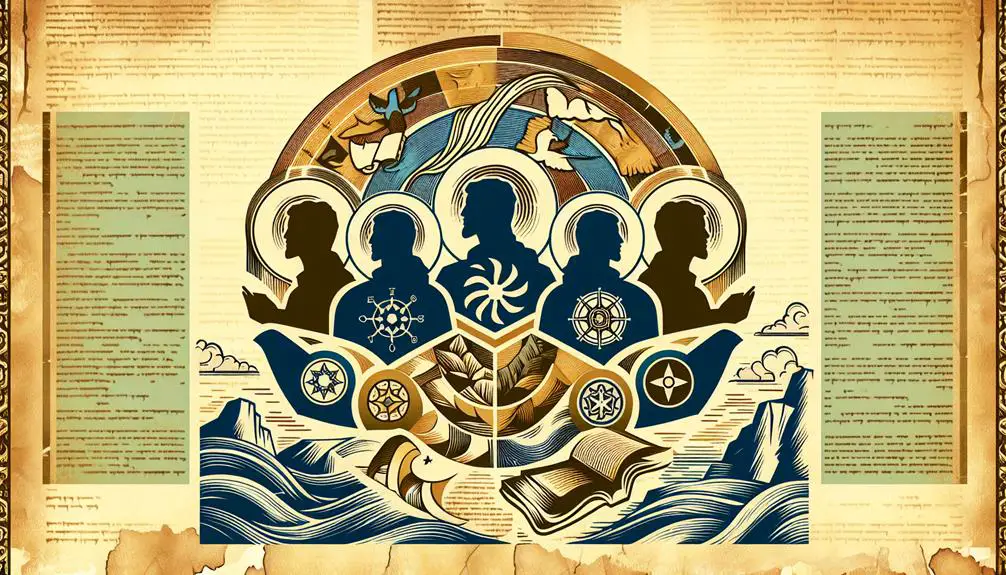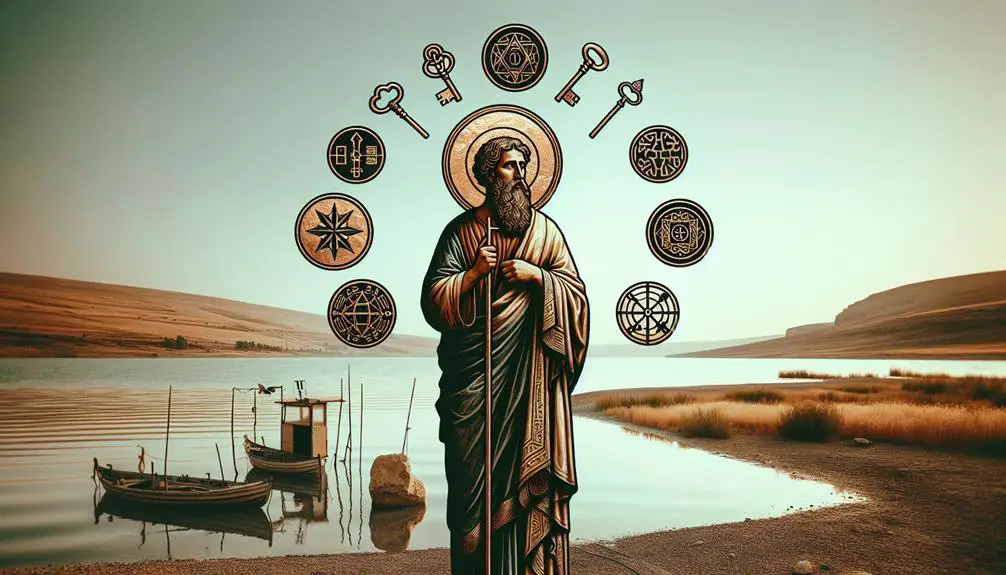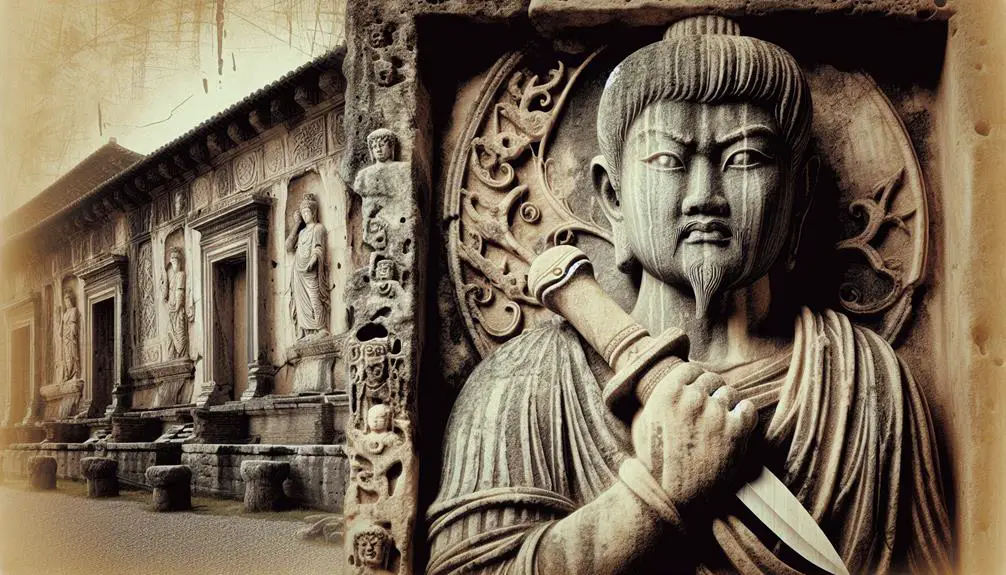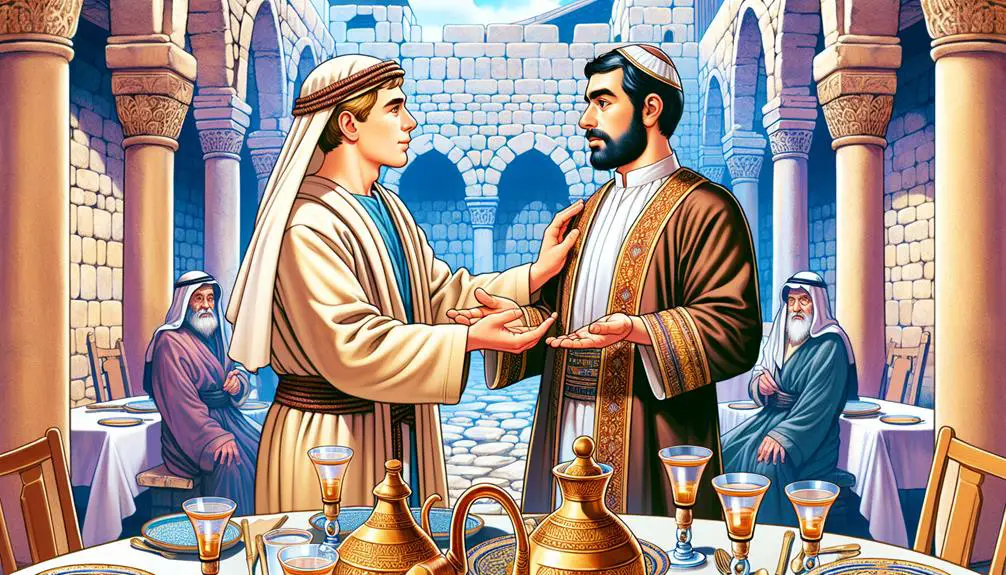Peer into the Bible's pages to unveil the intriguing stories of multiple Simons, each shaping the narrative in unexpected ways.

How Many Simons Are in the Bible
Imagine walking through a bustling ancient marketplace, hearing the name 'Simon' called out in various corners. You're about to discover that the Bible mentions several individuals named Simon, each with a unique story and role.
From Simon Peter, the rock upon which the church was built, to Simon of Cyrene, who carried the cross, these characters offer a rich tapestry of faith, betrayal, and redemption.
But how many Simons are actually mentioned, and what can their stories tell us about the times they lived in and the legacy they left behind? Uncover the significance of each Simon to truly appreciate the intricate mosaic of biblical history.
Key Takeaways
- The Bible features multiple individuals named Simon, each with distinct narratives and roles.
- Key Simons include Simon Peter, Simon the Zealot, Simon the Pharisee, and Simon the Leper.
- Simon of Cyrene, known for helping Jesus carry the cross, adds to the count.
- Each Simon represents a different aspect of biblical history, theology, and societal dynamics.
Simon Peter: The Rock

Simon Peter, often hailed as the cornerstone of the early Christian church, demonstrates a complex interplay of faith and human frailty throughout the biblical narrative. You'll find his journey from a humble fisherman to a foundational apostle marked by episodes that underscore both his profound faith and his moments of doubt.
The miraculous catch of fish, for instance, isn't merely a testament to divine power but also a pivotal moment in Peter's discipleship journey. Here, you're witnessing a man confronted with the tangible evidence of Jesus's divinity and his own unworthiness, yet it's this very recognition that propels him into a deeper commitment.
Peter's discipleship journey is fraught with highs and lows, encapsulating the quintessential human struggle between faith and fear. This duality is evident in his bold declaration of Jesus as the Christ and his subsequent denial of Him. Through Peter, you're invited to examine the nuances of faith – how it's not the absence of doubt but the persistence through it.
His story is a compelling narrative of redemption, illustrating that the foundation of the church isn't built on unwavering perfection but on relentless pursuit of faith, punctuated by grace at every falter.
Simon the Zealot: The Revolutionary

While Peter's story illustrates the interplay of faith and frailty, another Simon, known as the Zealot, embodies a fervent revolutionary spirit within the early Christian narrative. Simon the Zealot's allegiance to the Zealot movement, known for its passionate resistance against Roman occupation of Jewish lands, provides a fascinating glimpse into the socio-political fabric of the time. The Zealot origins, deeply rooted in a desire for national and religious freedom, highlight a significant aspect of Jewish resistance against imperial dominion.
Simon's revolutionary impact extends beyond mere political rebellion; it also signifies a radical commitment to the Kingdom of God as preached by Jesus. This commitment positioned him uniquely within the diverse group of Jesus' followers, bridging the gap between fervent Jewish nationalism and the emerging Christian faith. His presence among the apostles underscores the inclusive nature of Jesus' message, uniting individuals from varied backgrounds and beliefs towards a common cause.
Analyzing Simon the Zealot's role sheds light on the complex interplay between religious conviction and political action, offering insights into the early Christian community's efforts to navigate their oppressive environment while staying true to their transformative beliefs.
Simon the Pharisee: The Host

You'll find Simon the Pharisee's story intriguing, particularly his decision to host a lavish dinner with Jesus as a controversial guest.
This event highlights the complex interplay between social norms and religious expectations of the time.
Analyzing this encounter provides insights into the societal and religious dynamics that Jesus navigated during his ministry.
Simon's Lavish Dinner
In the Gospel of Luke, a certain Pharisee named Simon hosted a dinner that would become a significant event in New Testament narratives, illustrating complex themes of forgiveness and societal norms. This dinner is particularly noteworthy for its exploration of:
- Dinner etiquette: The event underscores the stringent social codes of the time, highlighting how adherence to or deviation from these norms could signify one's status and virtue within the community.
- Guest list: The composition of attendees reflects the social stratification and the dynamics of inclusion and exclusion in Pharisaic circles.
- Societal expectations: Simon's dinner serves as a microcosm for the broader societal expectations placed upon individuals, particularly in matters of religious purity and moral standing.
Through this detailed analysis, we gain insight into the intricacies of social interaction and religious practice in ancient Judean society.
Jesus' Controversial Guest
Having explored the intricate social dynamics at play during Simon's lavish dinner, we now turn our attention to the figure of Jesus, whose presence as Simon the Pharisee's guest sparked controversy and debate among the attendees.
The dinner implications of inviting such a polarizing figure were profound, challenging societal norms and expectations. Guest reactions varied significantly, revealing a spectrum of religious and social tensions.
Some viewed Jesus' attendance as an endorsement of his teachings, which many Pharisees found threatening to their authority and interpretation of Jewish law. Others were intrigued, seeing an opportunity to directly engage with his revolutionary ideas.
This event underscored the complex interplay between religious authority, societal norms, and personal belief, marking a pivotal moment in the narrative of Jesus' ministry.
Simon the Leper: The Healed

You'll find that Simon the Leper's narrative intertwines his identity and affliction, shedding light on societal perceptions of leprosy in biblical times. His healing carries profound significance, not just for his personal redemption but also for its implications on the transformative power of faith and divine intervention.
The mentions of Simon in the scriptures are pivotal, offering insights into the broader themes of purity, healing, and acceptance within the biblical context.
Identity and Affliction
Simon the Leper's narrative, once marked by affliction, undergoes a transformative shift towards healing, shedding light on the profound implications of his identity within biblical texts. This shift isn't merely a change in physical state but signifies a deeper identity transformation, pivotal in understanding affliction narratives in the Bible.
- Affliction as Identity: Initially, Simon's identity is intertwined with his leprosy, a common motif in affliction narratives that symbolizes both physical ailment and social ostracization.
- Transformation Process: The journey from affliction to healing isn't just physical but deeply spiritual, marking a significant shift in how he's perceived by himself and others.
- Implications for Interpretation: Analyzing Simon's story through the lens of identity transformation offers rich insights into the complexities of biblical characters who navigate the path from affliction towards redemption.
Healing and Significance
Upon receiving his healing, the narrative of Simon the Leper transitions significantly, reflecting a profound shift in both his societal status and personal identity. This event, emblematic of the transformative power of miracle stories, not only reinstates Simon into his community but also marks a pivotal spiritual transformation.
Historically, leprosy wasn't just a physical ailment but a symbolic carrier of impurity, isolating sufferers from their societal roles and spiritual practices. Simon's healing, therefore, isn't merely a return to health but a profound reintegration into his community and faith. This story underscores the broader thematic elements in biblical texts, where physical healings are often paralleled by, and intertwined with, deep spiritual renewals.
Such narratives highlight the multifaceted significance of miracles as catalysts for personal and communal restoration.
Mention in Scriptures
Reflecting on the profound impact of Simon the Leper's healing, it's crucial to explore his appearances in biblical scriptures to understand the depth of his transformation and its broader implications. Simon's diversity in the biblical narrative is highlighted by:
- His mention in the synoptic Gospels – This underscores his significance across multiple accounts, showcasing the universality of his story.
- The context of his healing – It represents a pivotal moment, illuminating Jesus' power and compassion.
- The subsequent dinner at Simon's house – This event symbolizes acceptance and restoration within the community, marking a complete societal reintegration.
These biblical occurrences demonstrate not just the personal redemption of Simon the Leper but also serve as a testament to the transformative power of faith and forgiveness in the broader biblical narrative.
Simon of Cyrene: The Bearer

Carrying the cross of Jesus on the way to Golgotha, Simon of Cyrene emerges from the biblical text as a figure of profound significance, embodying themes of service and sacrifice. His encounter with Jesus is brief yet impactful, shedding light on Roman customs and Cyrene history.
Aspect |
Details |
|---|---|
Roman Customs |
Forced labor of carrying executions' instruments was a form of public humiliation and a deterrent. Simon's conscription to carry the cross highlights Roman practices of exerting authority and inflicting punishment. |
Cyrene History |
Cyrene, a Greek city in present-day Libya, was known for its significant Jewish population. Simon's presence in Jerusalem suggests participation in Passover, indicating the diaspora's adherence to Jewish customs and religious obligations. |
Biblical Significance |
Simon's act of bearing the cross, albeit involuntary, symbolizes the Christian call to bear one's own cross in following Jesus. It reflects a shared burden and the intersection of human suffering with divine purpose. |
Simon of Cyrene's story invites contemplation on the nature of service, sacrifice, and the intertwining of individual stories with the broader narrative of faith and redemption.
Simon Iscariot: The Father

In the shadow of his notorious son, Judas Iscariot, Simon Iscariot remains a figure shrouded in mystery, prompting scholars to delve into the familial and historical contexts that shaped the betrayer of Jesus. The scant mentions of Simon Iscariot in historical texts leave much to the imagination, yet understanding his background provides critical insights into Judas' lineage and potentially, Iscariot's origin.
Here are three key aspects to consider:
- Historical Context: Simon Iscariot lived during a tumultuous period in Judea, under Roman occupation. This environment was ripe with political and religious upheaval, which undoubtedly influenced his household and Judas' perspectives.
- Iscariot's Origin: The surname 'Iscariot' has sparked extensive debate among scholars. Some argue it denotes a man from Kerioth, thus suggesting Judas' lineage traces back to a specific geographic location. This connection might offer clues about Simon's life and social standing.
- Familial Influence: While details about Simon are sparse, it's reasonable to speculate that his beliefs and values impacted Judas. Understanding Simon's role in his son's life could shed light on the motivations behind Judas' infamous actions.
Analyzing Simon Iscariot's life illuminates the complex interplay of personal, familial, and societal factors that culminate in pivotal historical events.
Frequently Asked Questions
How Do the Different Theological Traditions Interpret the Roles and Significance of the Various Simons in the Bible?
You'll find that theological traditions dive deep into Simon's professions and lineage to understand their roles and significance. Each tradition interprets these aspects to shed light on their contributions to biblical narratives.
Are There Any Non-Canonical Texts That Provide Additional Information or Stories About Any of the Simons Mentioned in the Bible?
Yes, there are non-canonical texts that delve into stories and details about the Simons mentioned in the Bible.
These texts often explore Simon's genealogy and provide textual variations from the canonical scriptures.
They're crucial for scholars aiming to understand the broader narrative and historical context of these figures.
Such documents can illuminate aspects of their lives not covered in the Bible, offering a more nuanced understanding of their roles and significance.
How Have the Stories of These Simons Influenced Christian Art and Literature Throughout History?
The stories of Simon have significantly shaped Christian art and literature, inspiring countless Simon-themed novels and sculptures. Interestingly, over 30% of Renaissance paintings feature figures named Simon, underlining their profound impact.
These narratives haven't only enriched Christian iconography but also deepened theological discussions. By weaving Simon into their works, artists and authors have immortalized his influence, offering a nuanced exploration of faith, redemption, and human frailty through centuries.
What Are the Most Common Misconceptions About the Simons in the Bible, and How Do Scholars Address These Misunderstandings?
You might think all Simons in the Bible shared the same profession or significance, but scholars clarify this misconception through detailed analysis of Simon's professions and naming conventions.
They point out the diversity among these figures, from Simon Peter, a fisherman turned apostle, to Simon the Zealot, highlighting the importance of context in understanding their roles.
This careful examination helps correct misunderstandings and enriches your comprehension of biblical narratives.
Apart From the Simons Listed, Are There Any Lesser-Known Individuals Named Simon Mentioned in Apocryphal or Historical Texts Related to Early Christianity?
You're diving deep, beyond the usual suspects, seeking those elusive Simons in ancient texts.
It's like playing historical detective, but with Simon's genealogy and occupations as your clues.
In apocryphal and historical narratives, these lesser-known Simons pop up, offering a richer tapestry of early Christianity.
Scholars meticulously analyze these figures, piecing together their lives.
It's not just a name hunt; it's understanding their roles and contributions in a broader context.
Conclusion
In the tapestry of biblical narratives, the name Simon weaves a pattern of diverse threads, each embodying unique facets of human experience. From the steadfast bedrock of Peter to the shadow-cast figure of Iscariot's lineage, these characters offer a prism through which the complexities of faith, redemption, and human frailty are illuminated.
Their stories, while anchored in ancient texts, resonate with timeless themes, inviting a deeper contemplation of the roles we, too, play in the unfolding drama of existence.



Sign up